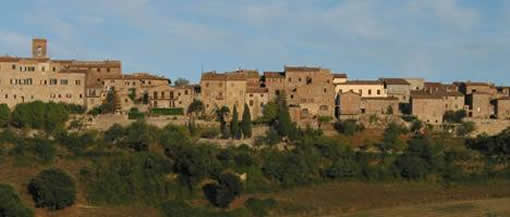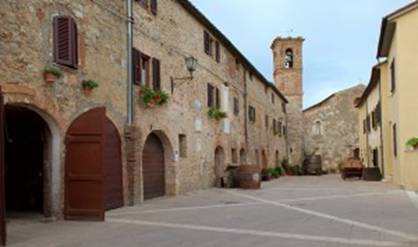INDEX
1. SIENA - MUSEUMS AND PALAZZI
2. SIENA - CHURCHES
3. PLACES WITHIN HALF AN HOUR OF BARONTOLI
5.HISTORICAL CHRONOLOGY
6. SIENESE PAINTERS
7. SAINTS IN ART
PLACES FURTHER AFIELD
RADICONDOLI, MENSANO AND CASOLE D'ELSA
Three small and ancient towns south of Colle Val d'Elsa, of moderate interest only, but worth a look if you are passing by.
Radicondoli
Radicondoli is the least interesting of the three. It is a picturesque small town with some quite substantial palazzi in its main street and a handsome l6th century church in the middle. The town has no modern shops - indeed few shops of any description - and its buildings are mostly constructed of a pleasing jumble of stone and mellow brick. From the main street, between the houses and through arches, sudden glimpses of Tuscan landscape enticingly appear. There is a particularly good glimpse down a street opposite the church, through an attractive mediaeval gateway, part of the original mediaeval fortifications. There is also an old 12th century church (la Pieve Vecchia) on the outskirts by the cemetery (cimitero), said to contain interesting pre-Romanesque carvings, but locked whenever we have been there.
Mensano
Mensano is barely more than a village, but still has mediaeval walls and a castle. It is chiefly interesting for its 12th century church, San Giovanni Battista, an attractive Romanesque basilica with alabaster windows and large interesting capitals on the monolithic columns in the nave, carved with the usual fantasy of leaves, primitive heads and strange animals. There are light switches behind the columns near the altar in the side aisles.
Casole d'Elsa

Casole d'Elsa is quite a lot bigger, and worth visiting for its Collegiata (church), which has some interesting paintings and sculptures.Traffic is restricted within the tiny hilltop centre, but from the main car-park below the town (paying except on Sundays), there are a series of lifts to the top.
The main square contains both the Colegiata della Assunta and a small museum. The church was originally Romanesque and retains its Romanesque doorway. But the wide interior was gothicised in the 15th century, imparting an impression of light and space, with great pointed arches over the main altar and the chapels on either side of it. The church was damaged in the Second World War, but has been well restored.
On the wall of the right hand nave, just beyond the entrance, there is a particularly attractive early 16th century terracotta relief of the Nativity and the Adoration of the Shepherds; a light beside it can be turned on, but it is still infuriatingly difficult to see. Further along, there is a fine early 14th century funerary monument by Gano da Siena to Bishop Tommaso Andrei, a scion of one of the two main families in Colle at that period. Opposite, another (early 1300s) funerary monument high on the wall commemorates “Messer Porrina”, a leading member of the other family, the Beltrami or Albertini. It also was thought to be by Gano da Siena. But the main expert on Sienese art, Giovanni Previtali, recently decided that it, and various other works in Siena and elsewhere, are by a hitherto neglected late 13th and early 14th century artist called Marco Romano – as his name indicates, an itinerant sculptor from Rome. The Beltrami family apparently gave him their patronage, and Casole is making much of Previtale’s discoveries..
High above the altar some remains of Duccio-period frescoes of the Last Judgement can be made out. There are further frescoes of the same period in a little chapel of the left aisle, including a Maiestà with Beltrami donors painted at the bottom.
Next to the church there is a tiny museum in the old cloister (open 10.00-12.00 and 16.00-19.00 except Monday), with the usual collection of local Etruscan finds and second-rate paintings, not really worth visiting. If you do go in, there is rather a good scene on an Etruscan vase on the first floor showing a satyr chasing a Maenead trying to wash herself, and an unusual 2nd century BC Etruscan tomb of a terracotta lady lying fully stretched out as if in sleep. The paintings of most interest are probably two taken from the church: a Virgin and Child with Massacre of the Innocents by Andrea di Niccolo; and opposite a Madonna and Saints (a particularly soupy-looking St Sebastian) by Giacomo Pacchiarotti (1520).
At the end of the main street (turn left on leaving the church) is the well restored little "Rocca" or fortress, now used as municipal offices - note the immense thickness of the walls, more than two metres. Pity also the less able of Casole’s residents who have to climb two extremely steep flights of steps to get to see the local officials on the upper floor.
1993 revised 2005 and (partially)2010
